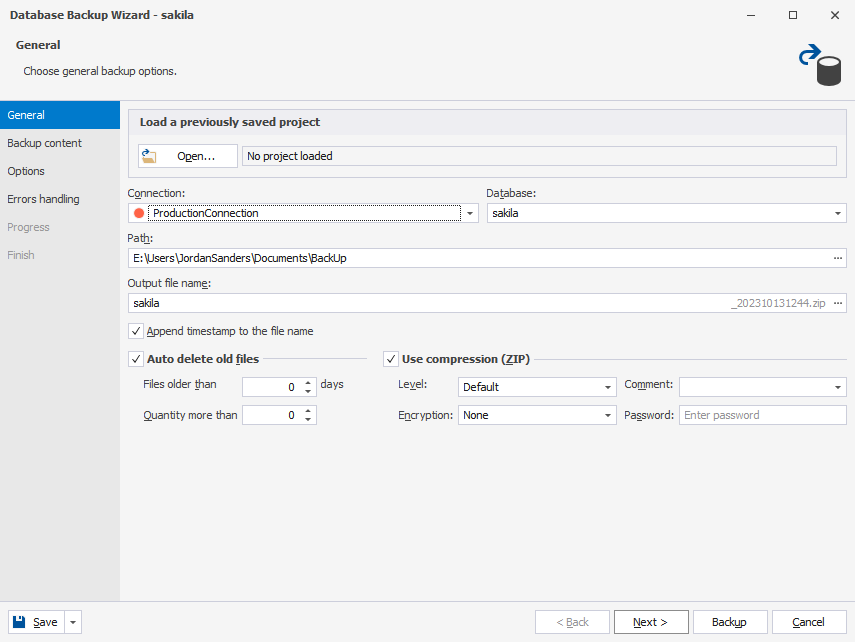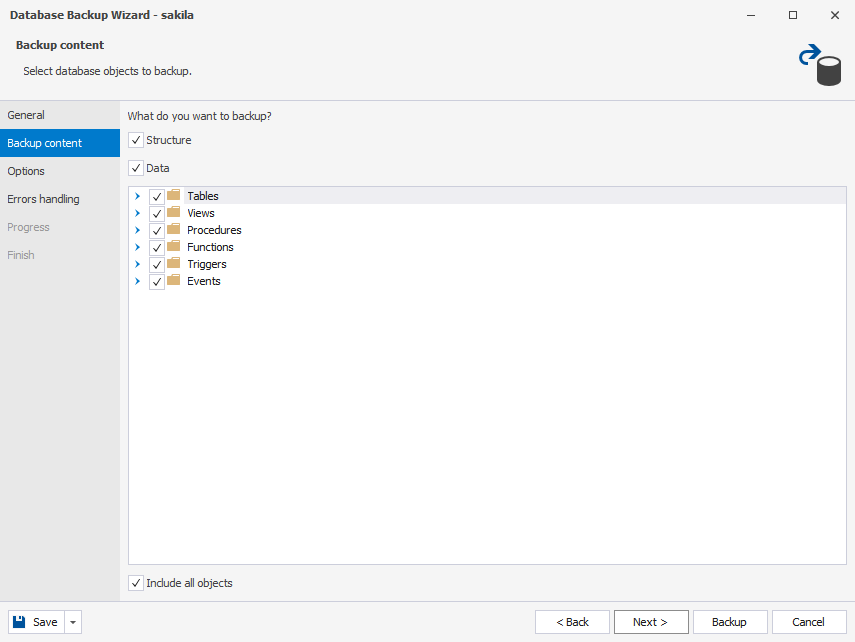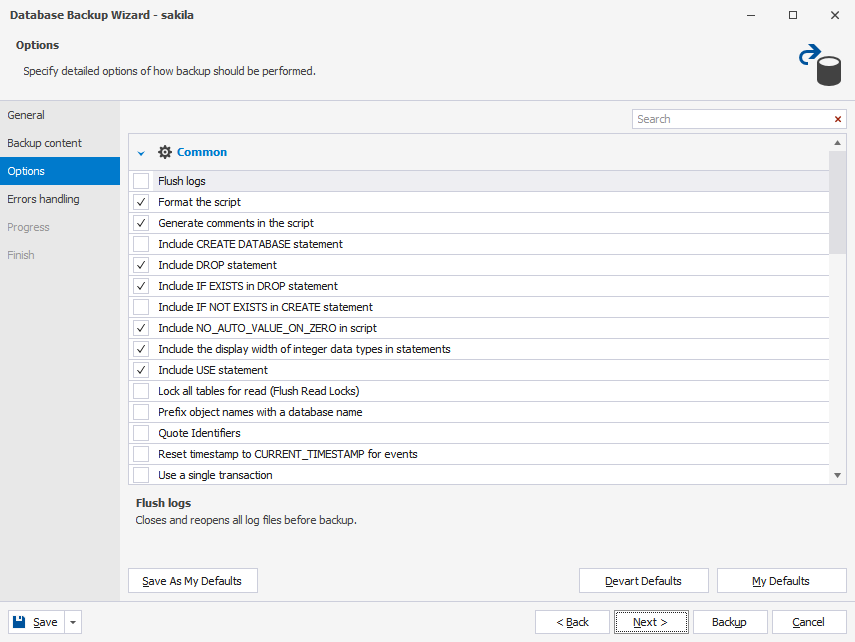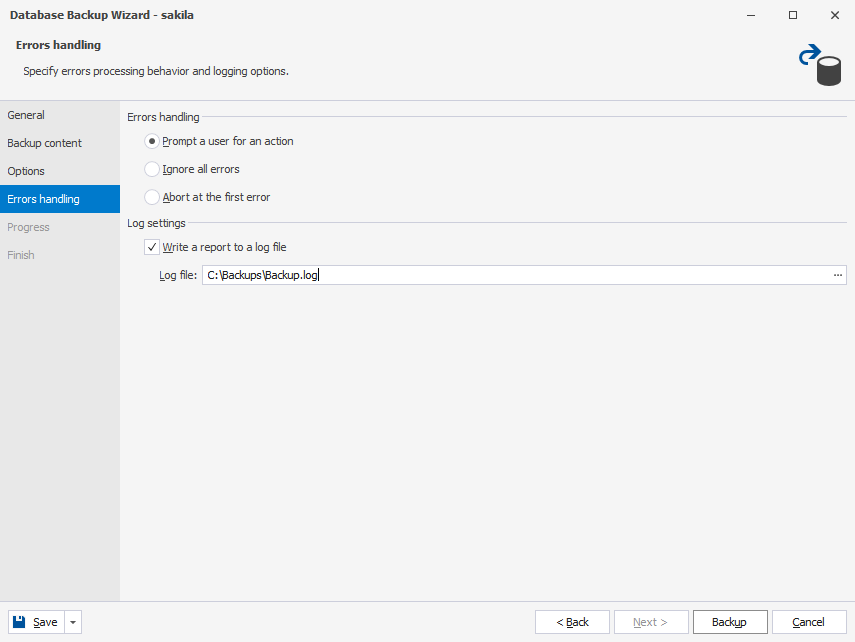Backup a database
In this example we will create the sakila database backup.
To backup the database:
1. Click Backup Database on the Administration tab of Start Page. The Database Backup Wizard opens.
2. Select a connection or click <Manage…> in the Connection list, and then click New to create a new connection. For more information about how to create a server connection see Connecting to a Database.
3. Once the connection is established, select a database you want to backup in the Database list.
4. Specify a folder path to store backups in the Path text box.
5. Specify an output file name in the respective text box.
6. Set up some optional settings such as: append time stamp to the file name, auto delete old files, use compression etc, at your own decision. Click Next.

7. Select database objects to backup and click Next.

8. Specify detailed options on how backup should be performed. Click Next.

9. Select the Write a report to a log file check box to save the backup process information to a log file. Enter the path where to store the file, for instance C:\Backups\Backup.log.

10. Click Backup.
11. As soon as the backup process has finished, click Save Project.

A project file contains all the information that you have entered while walkthrough the wizard pages.
Running Backup from the Command Line
To run a backup from the command line:
1. Click Start.
2. Type cmd in the Search programs and files text box and press the ENTER button.
Note
To run the Command Line in Windows 8, Windows 10, and Windows 11:
From the Desktop Mode
- Move the mouse cursor to the exact lower left corner until the desktop shortcuts menu appears.
- Right-click to see the shortcut menu and than click Run
From the Charms Bar
- Move your mouse to the upper right corner until the Charms Bar appears.
- Select Apps from the list and type run in the search box.
- Click Run from the search results.
Use Windows + R Shortcut Keys
- In desktop mode, press the Windows key and R at the same time to show the Run command line.
3. Enter the command line as follows and press ENTER:
"C:\Program Files\Devart\dbForge Studio for MySQL\dbforgemysql.com" /backup /projectfile:"c:\Backups\sakila.backup"
Note
The path to the executable file will differ depending on how you have installed the Studio - as a standalone tool or as part of the dbForge Edge bundle. Make sure that you have specified a correct path. If you have installed the Studio as part of dbForge Edge, change the path accordingly:
C:\Program Files\Devart\dbForge Edge\dbForge Studio for MySQL>dbforgemysql.com

After the process ends, a backup file appears in the specified directory.
Scheduling Database Backup
You can use the Windows Task Scheduler to create and manage backup tasks that your computer will carry out automatically at the times you specify.
To create Windows task:
1. Run the Windows Task Scheduler.
Note
To run the Windows Task Scheduler:
- Click Start and then click Control Panel.
- Click Administrative Tools.
If your current view is Category, click System and Security, and then click Administrative Tools.
- Click Task Scheduler.
3. Click the Action menu, and then click Create Basic Task.
4. Type a name for the task and an optional description, and then click Next.
5. Do one of the following:
- To select a schedule based on the calendar, click Daily, Weekly, Monthly, or One time, click Next; specify the schedule you want to use, and then click Next.
- To select a schedule based on common recurring events, click When the computer starts or When I log on, and then click Next.
- To select a schedule based on specific events, click When a specific event is logged, click Next; specify the event log and other information using the drop-down lists, and then click Next.
6. To schedule a program to start automatically, click Start a program, and then click Next.
7. Click Browse to enter a path to the .bat file that stores the command line string. For instance, a .bat file can contain a command line string as follows:
C:\Program Files\Devart\dbForge Studio for MySQL\dbforgemysql.com /backup /projectfile:c:\Backups\sakila.backup.
8. Click Next.
9. Click Finish.
Helpful materials
Backing Up All MySQL Server Databases or Only the Required Ones
Learn how to perform bulk backups for either all databases or a specific one with the help of dbForge Studio for MySQL.